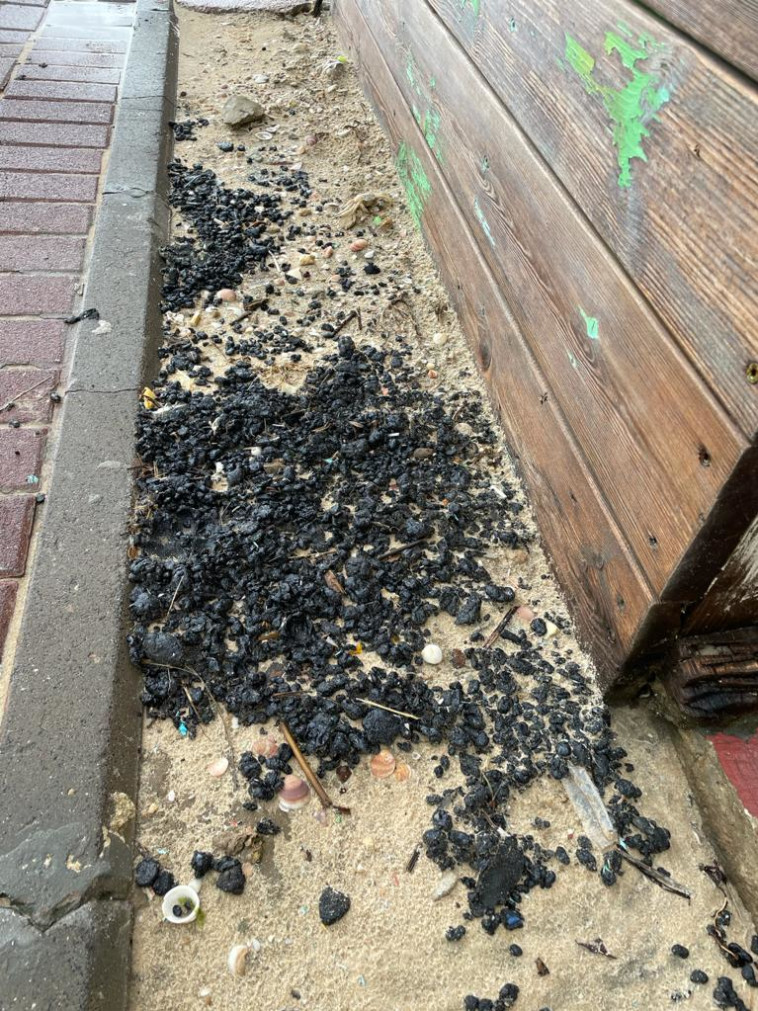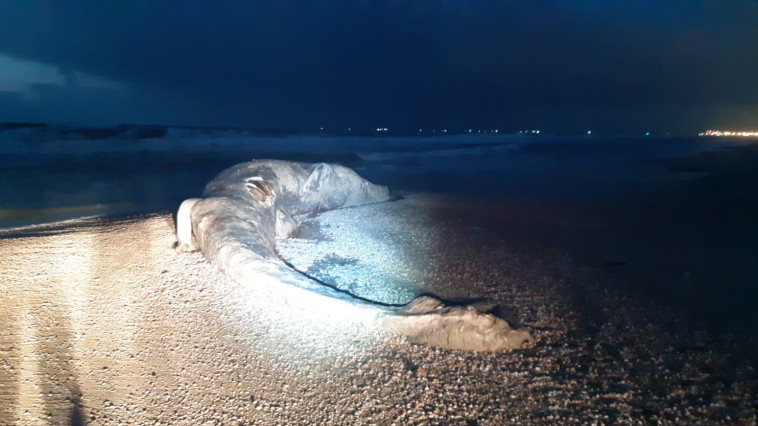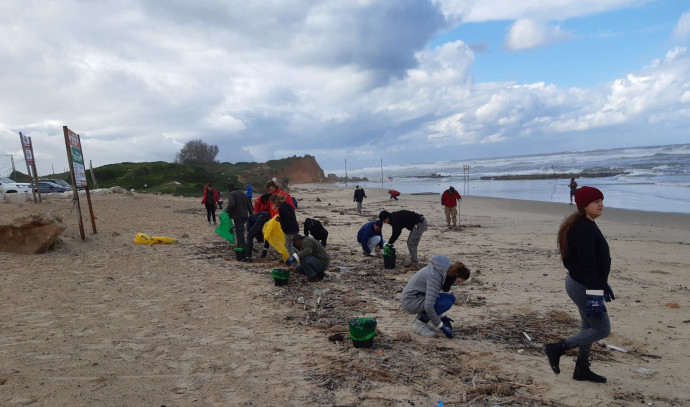Disaster of tar pollution on the shores of the Mediterranean: Today (Saturday) it became clear that the dimensions of the tar pollution, which was emitted during the recent storm from the Mediterranean Sea, reach a real ecological disaster that encompasses many beaches along the coastline in Israel, from Asher in the north to Ashkelon. The pollution, which began on Wednesday with the onset of stormy weather, did not miss nature reserves and national parks, from Rosh Hanikra to Nitzanim.
A manual and Sisyphean cleaning operation that includes hundreds of volunteers and environmental activists began as early as this weekend and will continue in the near future. Local authorities on the beaches will receive emergency assistance from the government to fund the operation. The Nature and Parks Authority asked the public not to come and clean independently and emphasized that the cleaning requires the use of appropriate protective measures in order to maintain health as well as a regulated evacuation to a suitable site.
After assessing the situation on Thursday evening, a tour of the beaches organized by the Minister of Environmental Protection, Gila Gamliel, took place on Friday with the director general of the Ministry of Environmental Protection, David Yahalomi, the director general of the Nature and Parks Authority, Shaul Goldstein. And the environment on the shores of the Dor Habonim Nature Reserve, a unique and beautiful reserve in the world. Also presented on the tour were the cleaning and rescue work performed and the work plan for continuing the fight against pollution.
Gamliel is even considering an appeal to Defense Minister Bnei Gantz to involve the Navy in investigating the source of the pollution that the director general of the Nature Authority defines as “the most serious natural disaster in Israel in recent decades due to the vast area it covers.”
- 2021 Elections: All the polls, articles and interpretations of leading reporters on the Maariv website
 Cleaning at Rishon Lezion Beach (Photo: Dror Arieli, Ministry of Environmental Protection)
Cleaning at Rishon Lezion Beach (Photo: Dror Arieli, Ministry of Environmental Protection)The investigation
The Ministry of Environmental Protection is investigating the source of the pollution, which is not yet known, and it appears that it is the emission of oils or oil from vessels that passed off the coast of Israel. In this type of incident, when the source of the contamination is unknown, the cleaning operations are carried out by the owners of the emergency plans – mainly the coastal local authorities. But unlike a situation where there is a known source, which can be sued for cleaning expenses, in the current situation there is no source of pollution, and therefore there is also still no source of claim and indemnification for the cleaning expenses.
“This is an event of a magnitude we have not seen for years and it is still not possible to assess the ecological and biological damage caused by it,” said Minister Gamliel on the tour. “We are doing everything we can to find the person responsible for the destruction of the beaches and the human damage to the animal environment. At this stage, the damage of the incident has not yet been fully clarified. Our joint work with local authorities is critical. Ministry of Environmental Protection works closely with those responsible. “That way we can reduce the damage and complete the cleaning as soon as possible.”
In assessing the situation prior to the tour, the minister emphasized: “The person responsible for the incident is no less a criminal and must pay the price. In addition, we will have to treat the animals damaged as a result of the pollution and rehabilitate them. We will find the source of the pollution. “The incident with question marks. The Ministry of Environmental Protection is leading the search for the source, and if we need assistance, we will contact the Minister of Defense to activate the navy on the mission.”
The Ministry of Environmental Protection’s Marine Unit is in contact with REMPEC in Malta, a regional center for responding to marine and coastal pollution in the Middle East, and with the European Maritime Protection Agency, EMSA, in an attempt to investigate possible sources of the incident. The ministry defined the incident at severity level 2 out of 3 according to the national emergency plan for dealing with a marine pollution incident.
 Tar pollution at Nitzanim Beach (Photo: Ministry of Environmental Protection, Yitzhak Kodowitzky)
Tar pollution at Nitzanim Beach (Photo: Ministry of Environmental Protection, Yitzhak Kodowitzky)The damages
Tar landings have been documented on the shores of 16 local authorities: Mate Asher Regional Council, Acre, Haifa, Tirat Carmel, Hof Hacarmel, Jisr a-Zarqa, Hadera, Emek Hefer, Hof Hasharon, Netanya, Herzliya, Tel Aviv, Bat Yam, Rishon Lezion, Ashdod, and Ashkelon Beach.
The Director General of the Nature and Parks Authority, Shaul Goldstein, clarified over the weekend: “For us, this is the most serious natural disaster that has occurred in recent decades in Israel, much more severe than the oil pollution in the Evrona Reserve in the Arava (December 2014 by EPA – 12). And from the industrial pollution disaster in the Nahal Ashalim Reserve in the Negev (June 2017 by the Rotem Ampert plant of the ICL Group – 12).
A whale ejected to shore. Photo: David Halfon Nature and Parks Authority
“This disaster extends from buds in the south to Rosh Hanikra. It goes up the beach and destroys habitats, infecting the sand, rocks, vegetation and animals with tar. The cleaning of this disaster will take a very long time and will require a lot of resources. But what is more serious, the cleaning will also be severe. “In the infrastructure of the beach with no choice. We share the Minister’s call for the public to enlist in this operation and very much hope that we will be able to organize to operate the public in an orderly manner.
According to Maya Yaakovs, CEO of Zalul, “This is a wake-up call for the government to stop the continued expansion of the offshore gas and oil industry, which is managed using the ‘nearby’ method without adequate supervision and enforcement, to prevent the oil transportation project. Change and establish an emergency system for renewable energies that are not polluting. “
Among the hundreds of small animal carcasses that perished in the pollution, including many sea turtles, the body of the giant whale that was ejected Thursday evening to the beach in the southern Nitzanim Reserve stood out. On Friday morning, samples were taken from the whale’s bodies by Dr. Aviad Sheinin, director of the supermassive field at the Morris Kahn Marine Research Station of the Charney School of Marine Sciences at the University of Haifa and director of the Dolphin and Marine Center of the Mahmali Association.
The results of the samples could link the tar contamination to the corpse, a connection that has not yet been proven. This is an adult male 17 meters long and weighing 25 tons. It is estimated that his body was dumped on the beach about two weeks after he died.
 A whale ejected ashore (Photo: David Halfon, Nature and Parks Authority)
A whale ejected ashore (Photo: David Halfon, Nature and Parks Authority)The cleaning operation
The Nature Authority asks the public not to reach the beaches at this stage due to tar that can be harmful to health and also not to engage in cleaning without the supervision and guidance of the authorities. You can register for the volunteer campaign in an orderly manner by email [email protected] or through the “Equation” association, which leads the recruitment of volunteers on its website.
Over the weekend, the affected local authorities, from Nahariya to Ashdod, assisted hundreds of environmental activists from the “Mediterranean People” organization, volunteer citizens and members of the Society for the Protection of Nature in the tar removal operation from the beaches that will continue in the coming days.
Following the guidance of Minister Gamliel, members of the management of the Marine Pollution Fund approved in principle support for the coastal local authorities for the treatment of tar damage that landed on the beaches in their area. “We have approved the transfer of emergency budgets to the local authorities for the benefit of the event, and we will soon advance the issue so that you receive the funds needed for the mission,” the minister said, adding:
“The event will not end in the next few days, we are preparing for hard and long work. There are places where engineering tools will not be useful, so the method of removing the tar is through working hands. We need volunteers and get many inquiries from citizens who want to help, and they can do so through local authorities.”
